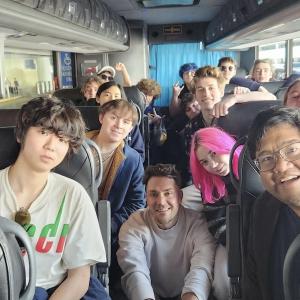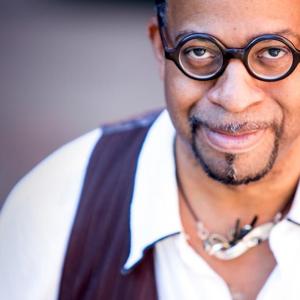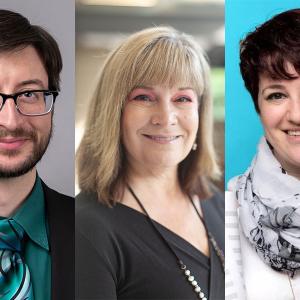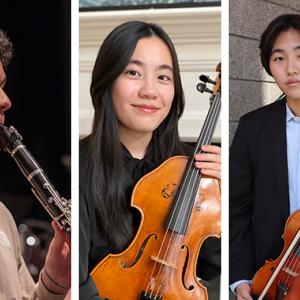Applications are still open for Arts Camp and Arts Academy. Programs fill quickly—submit your app today!
Interlochen’s newest building focuses on music
The Music Center fundamentally changes the way students learn, rehearse, and perform at Interlochen Center for the Arts.
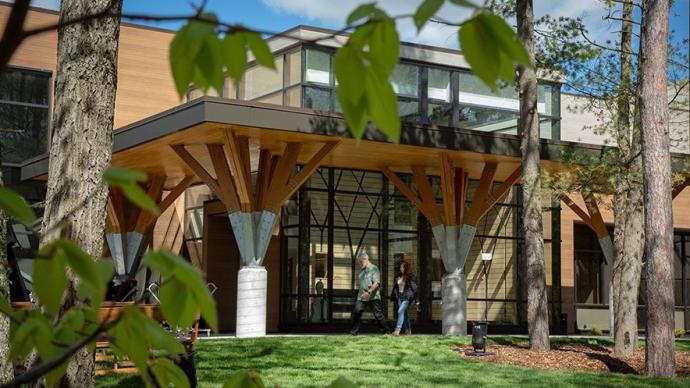
The main entrance to The Music Center at Interlochen Center for the Arts.
Nestled deep in the idyllic woods of northern Michigan lies a state-of-the-art facility—the new home for music at Interlochen Center for the Arts.
This three-leveled, 62,000 square-foot facility isn’t just about creating more indoor space on campus, but about fundamentally changing the way Interlochen students learn, rehearse, and perform for years to come.
The Music Center, situated in the heart of Interlochen Center for the Arts’ main campus, links Corson Auditorium with the Edward P. and Jessie Frohlich Piano and Percussion Building—creating one seamless complex with dozens of teaching studios, two rehearsal halls, numerous practice and ensemble rooms, recording studios, repair rooms, administrative offices, and observation points.
Work on the Music Center began decades before a single shovel of dirt was ever moved. In 1991, Sasaki Associates unveiled a set of ambitious plans for the revitalization of Interlochen Center for the Arts’ campus—which included concepts for a centralized home for the Music Department. Part of this music building proposal was realized in 1998 with the opening of the Edward P. and Jessie Frohlich Piano and Percussion Building. Though its completion alleviated several crucial concerns, the Music Division would remain mostly decentralized across Interlochen Center for the Arts’ 1,200 acre campus—utilizing space across various buildings and basements.
Through the CREATE AMAZING Campaign, the dream of the Music Center became a reality when $24 million was raised—fully funding the building. With the dedication of the Music Center on May 23, 2019, nearly all of the buildings proposed in those 1991 sketches have come to fruition in one way or another. To learn more about the Music Center dedication and campaign celebration, watch the CREATE AMAZING Campaign Finale video.
“Far more than stone and steel,” said President Trey Devey during the dedication, “the Music Center represents the legacy of so many who have cared to keep art alive and thriving here and around the world.”
Chair of Contemporary Music, Courtney Kaiser-Sandler, embodies that very ethos. An alumna herself, Kaiser-Sandler is well aware of the impact that The Music Center will have on her students. On the garden level of the facility, students—including singer-songwriters and those in the new music production and engineering program—have access to a professional recording studio. Digital and analogue workflows along with state-of-the-art equipment connect the studio building-wide. Adjacent to the studio through soundproof windows is The Mallory Ensemble Room, which houses a stage, lighting truss, and full audio connectivity.
“Having a professional stage with a full sound set-up and lights for performance practice, along with a recording studio, is a game-changer for our students,” Kaiser-Sandler said. “But it’s not just about that. Putting music students and faculty in the same building allows for more collaboration, and will improve overall communication.”
Much of that collaboration will be made in The Music Center’s two rehearsal halls, nine ensemble rooms, 25 teaching studios, and 10 practice rooms. To adequately soundproof a facility that at any given time could contain multitudes of musicians, a “box-in-box” approach was used in the design. Simply put: each room was built twice.
In the center of the building on the Herbert H. and Grace A. Dow Foundation Main Level, twin 3,200 square-foot rehearsal halls host the institution’s largest ensembles. Each space features double masonry walls separated by four inches of insulation to control acoustic bleedthrough, a double-layered floating roof system to minimize rain noise, and a floating floor resting on anti-vibration rubber isolators. Those hoping to watch ensembles rehearse without interruption can do so from observation balconies located on the upper level of the building.
Considerable effort was put into designing each of the 250 square-foot teaching studios. Every room features moveable acoustic paneling which allows faculty members to tune their space, non-parallel side walls to help prevent sound reverberation, and a louvered ceiling with special cantilevered lighting to eliminate unwanted vibrations. Even the doors were taken into consideration; unique hinges that lower the door when closed help isolate sounds within the room. Additionally, a high efficiency, low-flow HVAC system was incorporated to minimize sound from the building’s heating and cooling system.
Faculty and staff members provided input and feedback throughout the process. During an on-site visit during construction, Instructor of Percussion Keith Aleo brought along a tape measure to ensure that a five-octave marimba would fit easily in-and-out of his studio.
J. Berry, Assistant Director of Instrument Services and Music Operations, was able to work in extra long shelves for trombones and bass clarinets in the instrument repair shop, a tub large enough to submerge a BBb tuba with separate drainage systems for chemicals, and ventilation systems in both the string and wind/brass repair shops. Additionally, Berry asked for and received her favorite feature of her new shop: a garden-level skylight.
Elevation differences across campus created unique challenges with the Music Center’s design. A two-foot difference between the Edward P. and Jessie Frohlich Piano and Percussion Building and Corson Auditorium meant that the facility needed specifically sloped ramps to make it ADA compliant, and to make moving pianos from one end of the complex to the other possible. Scale models of the Music Center were built to test the building’s various inclines. Only when a caster or piano wheel cleared a ramp were the designers satisfied with the plans.
As Provost Camille Colatosti adds, “The Music Center will be transformational for Interlochen’s music community, providing students and faculty access to cutting edge technology in an unparalleled space for learning and collaboration. As young musicians spend their days practicing in the ensemble rooms, recording each other in the studios, and observing peer rehearsals, natural creative synergies will emerge. Inspired by the beauty of The Music Center, musicians will, in turn, inspire each other.”
